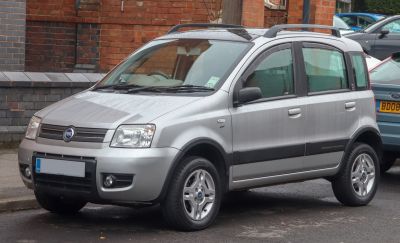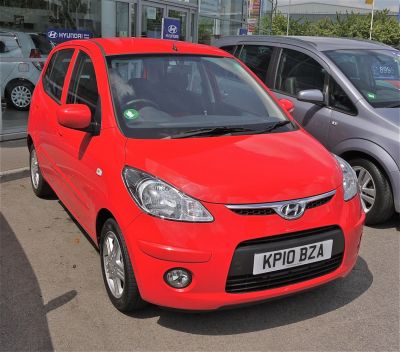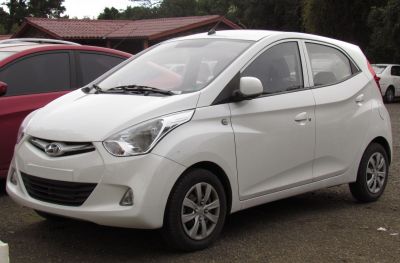 2003 Fiat Panda II (169) Dimensions, Size & Specs
2003 Fiat Panda II (169) Dimensions, Size & SpecsMeasurements of the 2003 Fiat Panda II, engineered for optimal performance and comfort
| Dimensions | |
|---|---|
| Length: | 3538-3578 mm139.3-140.9 in11.6-11.7 ft |
| Width: | 1578-1606 mm62.1-63.2 in5.2-5.3 ft |
| Height: | 1540-1614 mm60.6-63.5 in5.1-5.3 ft |
| Trunk Capacity: | 190-206 liter6.7-7.3 cu ft |
| Trunk Capacity (Max): | 775-860 liter27.4-30.4 cu ft |
| Weight Specifications | |
| Curb Weight: | 840-1050 kg1852-2315 lbs |
| Maximal permitted Weight: | 1255-1425 kg2767-3142 lbs |
| Roof Load: | 50 kg110 lbs |
| Tire Specifications | |
| Rims Sizes: | 13-inch rims:
|
| Tire Sizes: |
|
The Fiat Panda II (169), produced from 2003 to 2012, is a versatile compact hatchback designed primarily for city driving and practical use. It features a length range of approximately 3538 to 3578 mm (139.3 to 140.9 inches), making it easy to maneuver and park in urban environments. The width varies between 1578 and 1606 mm (62.1 to 63.2 inches), providing a balanced stance without compromising narrow street accessibility, while the height ranges from 1540 to 1614 mm (60.6 to 63.5 inches), offering a roomy interior feel typical for its segment. Curb weight spans from 840 kg to 1050 kg (1852 to 2315 lbs), keeping the vehicle light and efficient, with a maximum weight capacity between 1255 kg and 1425 kg (2767 to 3141 lbs), supporting passengers and cargo comfortably.
Luggage space in the Fiat Panda II is practical for its class, featuring a trunk capacity of 190 to 206 liters (6.7 to 7.3 cubic feet) with rear seats upright. Folding the rear seats expands the storage significantly to between 775 and 860 liters (27.4 to 30.4 cubic feet), allowing the Panda to handle larger items or luggage needs. Roof load capacity is rated at 50 kg (110 lbs), enabling additional transport options such as roof boxes or sports equipment carriers.
The Panda II rides on various rim sizes including 5Jx13, 13, 15, and 14 inches, paired with tire sizes ranging from 155/80 R13 and 165/65 R14 to sportier options like 195/45 R15. These configurations offer a mix of comfort, handling, and economy depending on the desired variant or trim level.
Overall, the Fiat Panda II (169) stands out as a compact, lightweight, and practical hatchback well-suited for urban environments and small families, combining efficient dimensions with flexible cargo solutions and a lightweight build for economical driving.
Discover the standout features that make the 2003 Fiat Panda II a leader in its class
Have a question? Please check our knowledgebase first.
The Fiat Panda II (169), produced from 2003 to 2012, measures between 3538 mm and 3578 mm in length (approximately 139.3 to 140.9 inches). Its width ranges from 1578 mm to 1606 mm (about 62.1 to 63.2 inches), and the height varies from 1540 mm to 1614 mm (around 60.6 to 63.5 inches). These compact dimensions categorize it firmly in the city hatchback segment, making it very maneuverable and ideal for urban driving. Its relatively tall height compared to its footprint allows for spacious interior headroom despite its small footprint.
The Fiat Panda II has a curb weight ranging from 840 kg to 1050 kg (approximately 1852 to 2315 lbs), depending on the variant and equipment level. The lighter models, closer to 840 kg, are typically the more basic trims with smaller engines and fewer features, while the upper end closer to 1050 kg corresponds to models with more equipment and possibly larger engines or 4x4 variants. This relatively low weight contributes to the car’s nimble handling and fuel efficiency.
The Fiat Panda II's maximum weight, or gross vehicle weight rating (GVWR), lies between 1255 kg and 1425 kg (approximately 2767 to 3140 lbs). This number includes the vehicle's curb weight plus passengers, cargo, and any additional load. Subtracting the curb weight, the payload capacity thus ranges roughly from 200 to 585 kg (440 to 1290 lbs), depending on the model. This capacity allows for four adults and reasonable luggage without overloading the vehicle, making it suitable for daily use and short trips.
The luggage capacity in the Fiat Panda II ranges from 190 to 206 liters (approximately 6.7 to 7.3 cubic feet) with the rear seats in the upright position. This is enough for a few small suitcases or bags, reflecting its nature as a city-oriented hatchback. When the rear seats fold down, the cargo space significantly increases to between 775 and 860 liters (about 27.4 to 30.4 cubic feet), allowing for transport of larger items or bulkier cargo. This flexibility enhances the car’s utility despite its overall compact size.
The Fiat Panda II has a roof load capacity of 50 kg (approximately 110 lbs). This means you can safely mount roof racks, bike carriers, or roof boxes as long as the combined weight of the carrier and its contents does not exceed this limit. This capacity is typical for compact cars in the hatchback category and should be carefully observed to maintain vehicle stability and safety.
The Fiat Panda II comes with various tire and rim sizes depending on the specific trim and model year. The rim sizes include 5J x 13, 13, 14, and 15 inches, providing options for different driving preferences and ride comfort. Tire sizes commonly fitted are 155/80 R13, 165/65 R14, 165/70 R14, and 195/45 R15. These dimensions offer a balance between road grip, ride comfort, and fuel efficiency suitable for city and suburban driving conditions.
Yes, the Fiat Panda II comfortably fits into a standard garage. Standard single garage dimensions typically measure around 2.4 to 3 meters in width, 5.4 to 6 meters in length, and about 2.1 to 2.4 meters in height. With the Panda II's width ranging from 1.578 to 1.606 meters (62.1 to 63.2 inches), length between 3.538 and 3.578 meters (139.3 to 140.9 inches), and height roughly 1.54 to 1.614 meters (60.6 to 63.5 inches), it leaves ample room on all sides for opening doors and moving around inside a standard garage. Its compact exterior makes it perfectly suited for tight urban environments and limited parking spaces.
Compared to the first-generation Fiat Panda (produced from 1980 to 2003), the Panda II (169) maintained a similar compact footprint but was modernized. The Panda II is generally slightly longer and wider, with a length between 3538 and 3578 mm versus roughly 3330 mm for the original, and a width increasing from about 1470 mm to up to 1606 mm. Height also increased from about 1500 mm to a max of 1614 mm, offering better interior space and comfort. The updated design brought enhanced safety, improved build quality, and more contemporary styling while preserving the Panda’s core identity as a small urban hatchback. The newer generation also benefits from refined suspension and more modern engine options.
The Fiat Panda II competes with small city-oriented hatchbacks like the Volkswagen Lupo, Toyota Yaris, and Suzuki Swift from the same era. Dimensions are competitive, with the Panda being slightly taller, offering a more upright seating position and more headroom. While its length and width are similar or slightly smaller than rivals, the Panda’s clever interior packaging provides relatively generous cargo space (up to 860 liters with seats folded) compared to some competitors. It is often praised for its practicality in tight urban spaces, reliable simplicity, and ease of maneuverability. However, in terms of refinement and driving dynamics, some competitors may offer more modern engines or features, but the Panda II remains a favorite for buyers valuing functionality and affordability.
The Fiat Panda II was primarily available as a hatchback, designed for efficient urban mobility and practicality. Production spanned from 2003 to 2012 and included various trim levels and engine options, including petrol, diesel, and 4x4 variants, which added some off-road capability to the small car segment. The hatchback body style emphasized compact dimensions with practical access to the rear seats and cargo area. This generation also saw special editions and optional equipment tailored to different market needs, reinforcing its position as a versatile and sensible city car.
Discover similar sized cars.

| Production: | 2004-2012 |
|---|---|
| Model Year: | 2004 |
| Length: | 3538-3574 mm139.3-140.7 in |
| Width: | 1578-1605 mm62.1-63.2 in |
| Height: | 1540-1632 mm60.6-64.3 in |

| Production: | 2008-2010 |
|---|---|
| Model Year: | 2008 |
| Length: | 3548 mm139.7 in |
| Width: | 1580 mm62.2 in |
| Height: | 1544 mm60.8 in |

| Production: | 2008-2010 |
|---|---|
| Model Year: | 2008 |
| Length: | 3565 mm140.4 in |
| Width: | 1595 mm62.8 in |
| Height: | 1540 mm60.6 in |

| Production: | 2011-2019 |
|---|---|
| Model Year: | 2012 |
| Length: | 3495 mm137.6 in |
| Width: | 1550 mm61.0 in |
| Height: | 1500 mm59.1 in |

| Production: | 2024-present |
|---|---|
| Model Year: | 2020 |
| Length: | 3620 mm142.5 in |
| Width: | 1652 mm65.0 in |
| Height: | 1577-1605 mm62.1-63.2 in |
